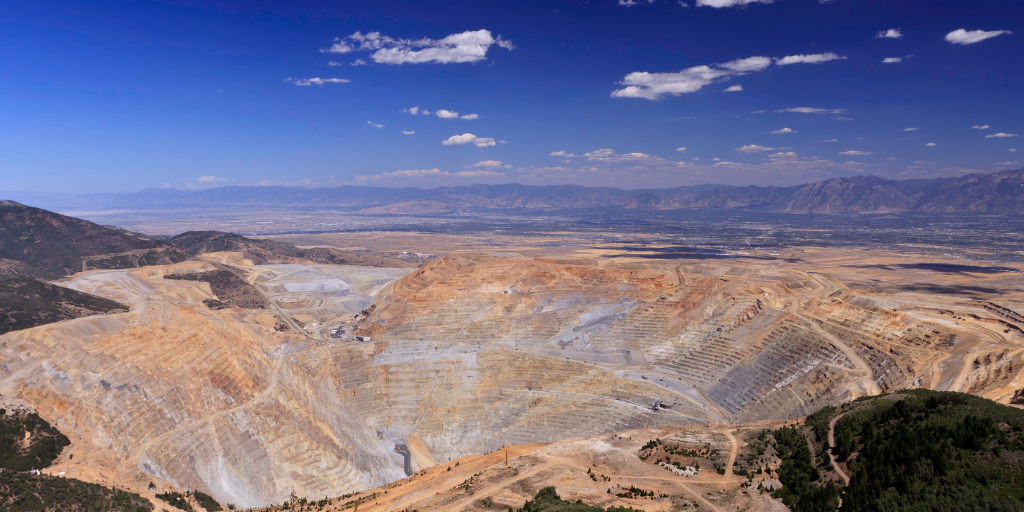This piece from TWW Visiting Fellow Simon Lomax first ran in the Deseret News on July 7th and can be accessed here.
Utah’s Kennecott copper mine produces one of Earth’s rarest metals — tellurium. Vital to low-carbon technologies, this mining project can help us reduce our carbon emissions
For more than a decade, the U.S. economy has been moving from high-carbon fuels to low- and zero-carbon fuels at an impressive rate. Overall U.S. carbon emissions have fallen almost 20% since their peak in 2007, as cleaner energy sources became cheaper and more reliable than the old mainstays of the power grid — especially coal.
But the next phase of the energy transition will be more challenging.
Just think about all the raw materials it will take to speed up the expansion of renewable power, energy storage, electric vehicles and many, many other low-carbon technologies.
If we don’t have secure, affordable and reliable access to the building blocks of clean energy technologies, then we can’t have a clean energy economy. If that wasn’t obvious before the pandemic — which turned global supply chains for all kinds of basic goods upside down — it’s crystal clear now.
That’s why the addition of a new production line at the Kennecott copper mine, located 30 miles southwest of Salt Lake City, is a really big deal.
In early May, the mine’s owner, Rio Tinto, started producing tellurium, a critically important mineral for the manufacture of advanced thin-film solar panels.
Tellurium is one of the rarest of the Earth’s rare elements. It’s about eight times rarer than gold, and at this moment, global production of tellurium is dominated by China, according to the U.S. Geological Survey.
For this reason, Utah Gov. Spencer Cox says the addition of tellurium production at the Kennecott mine is a matter of national security. At the opening of the facility, Cox even compared this new tellurium production capability to the three squadrons of stealth fighter jets stationed at nearby Hill Air Force Base.
“I think what we’re doing today is just as important as the F-35s at Hill Air Force Base for national security,” he said.
Rio Tinto projects the Kennecott mine will supply 20 tons of tellurium per year, or roughly 4% of global production, according to USGS estimates. After it’s refined by semiconductor manufacturer 5N Plus, the tellurium will be used by First Solar to produce finished solar panels in the industrial Midwest.
Headquartered in Tempe, Arizona, First Solar is about to open its third manufacturing plant in Ohio, which the company says is “the largest fully vertically integrated solar manufacturing complex outside China.”
Without tellurium and other raw materials, however, those solar factories in Ohio would grind to a halt. Therefore, working with 5N Plus and First Solar “is an important step towards securing a North American supply chain of critical minerals to support the clean energy transition,” says Clayton Walker, chief operating officer of Rio Tinto Copper.
Producing tellurium at the Kennecott mine isn’t just about securing a domestic supply chain for clean energy technologies, however. It’s also the latest example of “full value mining,” an industry term that means finding ways to get different kinds of metals and other valuable materials out of the same mine.
While copper is the primary metal at the Kennecott mine, there are several others being produced there too, including gold, silver and — of course — tellurium.
But until now, it wasn’t economical to remove the tellurium from the copper-bearing ores, because officials at the mine didn’t have a customer to buy and refine it. Now they do, thanks to recent growth and planned expansions in domestic solar manufacturing.
Besides the economic upside, full value mining also has major environmental benefits. When more minerals are produced from the same mine, there’s less waste to manage and smaller surface impacts. Not only that, where mining waste already exists in tailings dams and other storage facilities, that waste can be reprocessed to unlock minerals that have become more valuable due to the energy transition.
Just as important, adopting a full value approach to mining in the U.S. can reduce our imports of critical minerals, like tellurium, that are mostly produced overseas with fewer environmental safeguards than those we take for granted here in North America.
To be clear: Securing a domestic supply chain for critical minerals and clean energy technologies will not happen on its own.
After decades of discouraging investment in the U.S. mining sector, policymakers will have to find ways to encourage new and expanded production of copper, tellurium, lithium, cobalt, nickel and all the other essential ingredients for a carbon-neutral economy.
That won’t be easy, but it will be worth the effort. Just ask the Utah miners and Ohio solar workers who are already showing us the way.
Simon Lomax is a visiting fellow with The Western Way, a conservative nonprofit that seeks pro-market solutions to environmental challenges, and an editor-at-large with the Payne Institute for Public Policy at the Colorado School of Mines. He is a former climate reporter for Bloomberg News and a former congressional fellow with the American Political Science Association.

